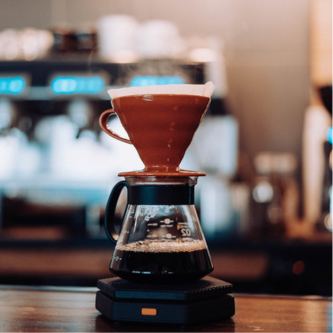Coffee makers have become an essential appliance for many people, providing that much-needed jolt of caffeine to kick start their day.
But a common question that arises is whether it is safe and energy-efficient to leave a coffee maker plugged in when not in use.
Leaving a coffee maker plugged in when not in use can pose several risks and drawbacks. First, there is a potential risk of electrical fires due to faulty wiring or power surges. No, it is generally not recommended to leave a coffee maker plugged in when not in use.
In this article, we will explore the various factors to consider when deciding whether it’s okay to keep your coffee maker connected to the power source.
The Importance of Coffee Makers
Coffee makers have become a staple in households and workplaces, offering convenience and the ability to brew a fresh cup of coffee whenever desired.
However, understanding the implications of leaving them plugged in is crucial for safety, energy efficiency, and environmental reasons.
Power Consumption of Coffee Makers
A. Standby Power:
Coffee makers, like many other electrical devices, consume a small amount of power even when not in use. This is often referred to as standby power or vampire power. While the amount of standby power consumed by coffee makers may vary, it is generally low compared to other appliances such as refrigerators or air conditioners.
B. Energy Efficiency of Modern Coffee Makers:
It’s worth noting that modern coffee makers have made significant strides in energy efficiency. Manufacturers have incorporated features like auto-shutoff and energy-saving modes, reducing power consumption during idle periods. When considering whether to leave your coffee maker plugged in, the energy efficiency of your specific model plays a vital role.
Safety Considerations
A. Risk of Electrical Fires:
Although the risk is relatively low, leaving any electrical device, including coffee makers, plugged in indefinitely increases the chances of electrical fires. Faulty wiring, power surges, or manufacturing defects can potentially lead to hazardous situations. It is important to assess the safety features of your coffee maker and be aware of any recalls or maintenance requirements.
B. Electrical Safety Precautions:
To mitigate potential risks, it is recommended to follow general electrical safety precautions. Ensure your coffee maker is connected to a properly grounded outlet, avoid using extension cords, and inspect the power cord for any signs of damage regularly. Additionally, consider using a surge protector to safeguard against power fluctuations.
Environmental Impact
A. Energy Waste:
Leaving appliances unnecessarily plugged in contributes to energy waste. While the energy consumption of a single coffee maker may seem insignificant, the collective impact of millions of coffee makers can have a considerable environmental footprint. Conserving energy by unplugging appliances when not in use helps reduce carbon emissions and conserve natural resources.
B. Environmental Footprint:
The production and disposal of coffee makers have environmental implications. By reducing unnecessary energy consumption, we indirectly reduce the demand for energy production, which often relies on fossil fuels.
Furthermore, disposing of coffee makers improperly can lead to electronic waste that ends up in landfills. Sustainable practices, including responsible usage and proper disposal, can mitigate these impacts.
Longevity and Maintenance
A. Wear and Tear on Components:
Continuous exposure to electricity, even in standby mode, can lead to wear and tear on the internal components of a coffee maker. Over time, this may affect its performance and lifespan. Unplugging the device when not in use can potentially extend its longevity.
B. Regular Cleaning and Maintenance:
Proper maintenance is essential for the longevity and functionality of your coffee maker. Unplugging the appliance allows for a safe and thorough cleaning, preventing the accumulation of coffee residue and mineral deposits. Refer to the manufacturer’s guidelines for specific cleaning instructions.
Personal Preferences and Convenience
A. Instant Availability of Coffee:
For some, the convenience of having a coffee maker ready to brew at any moment outweighs the potential energy consumption.
If you frequently enjoy multiple cups of coffee throughout the day, leaving the coffee maker plugged in can be a matter of personal preference and convenience.
B. Easy Access for Daily Use:
Having a coffee maker readily available eliminates the need to plug and unplug it each time you want to brew coffee.
If you use your coffee maker frequently and find it inconvenient to plug and unplug, keeping it connected may be a reasonable choice for you.
Energy Saving Tips
A. Unplugging vs. Standby Mode:
If you decide to unplug your coffee maker, it is crucial to weigh the convenience against the potential energy savings.
Consider your daily usage patterns and determine whether the effort of unplugging is worth the energy conservation.
B. Using Timers or Programmable Coffee Makers:
Utilizing the timer or programmable features of your coffee maker can be an effective way to reduce energy consumption.
Set the device to turn on shortly before you wake up or return home, ensuring your coffee is ready without the need for continuous power.
Conclusion
While the decision of whether to leave your coffee maker plugged in ultimately depends on your personal circumstances and preferences, it’s important to consider factors such as energy consumption, safety, environmental impact, and longevity.
By assessing these factors, you can make an informed choice that balances convenience, energy efficiency, and safety.
Remember, responsible usage and maintenance practices go hand in hand with ensuring the longevity and efficiency of your coffee maker while minimizing its environmental impact.

